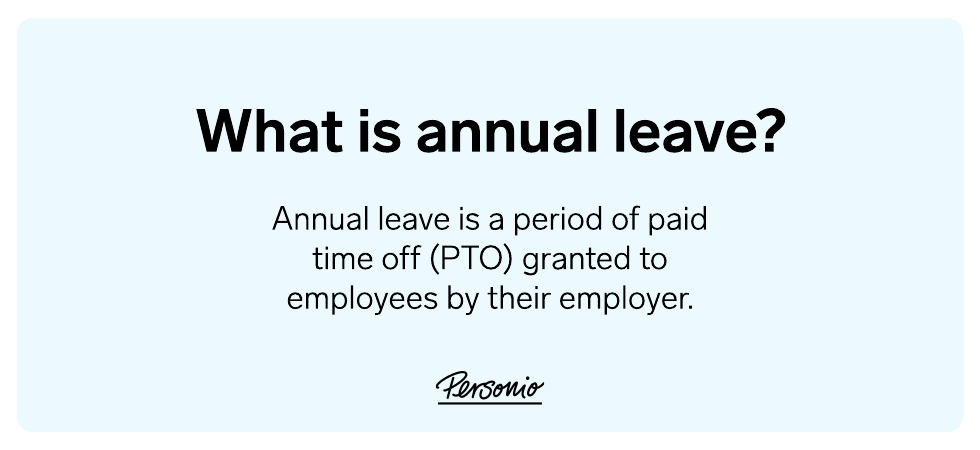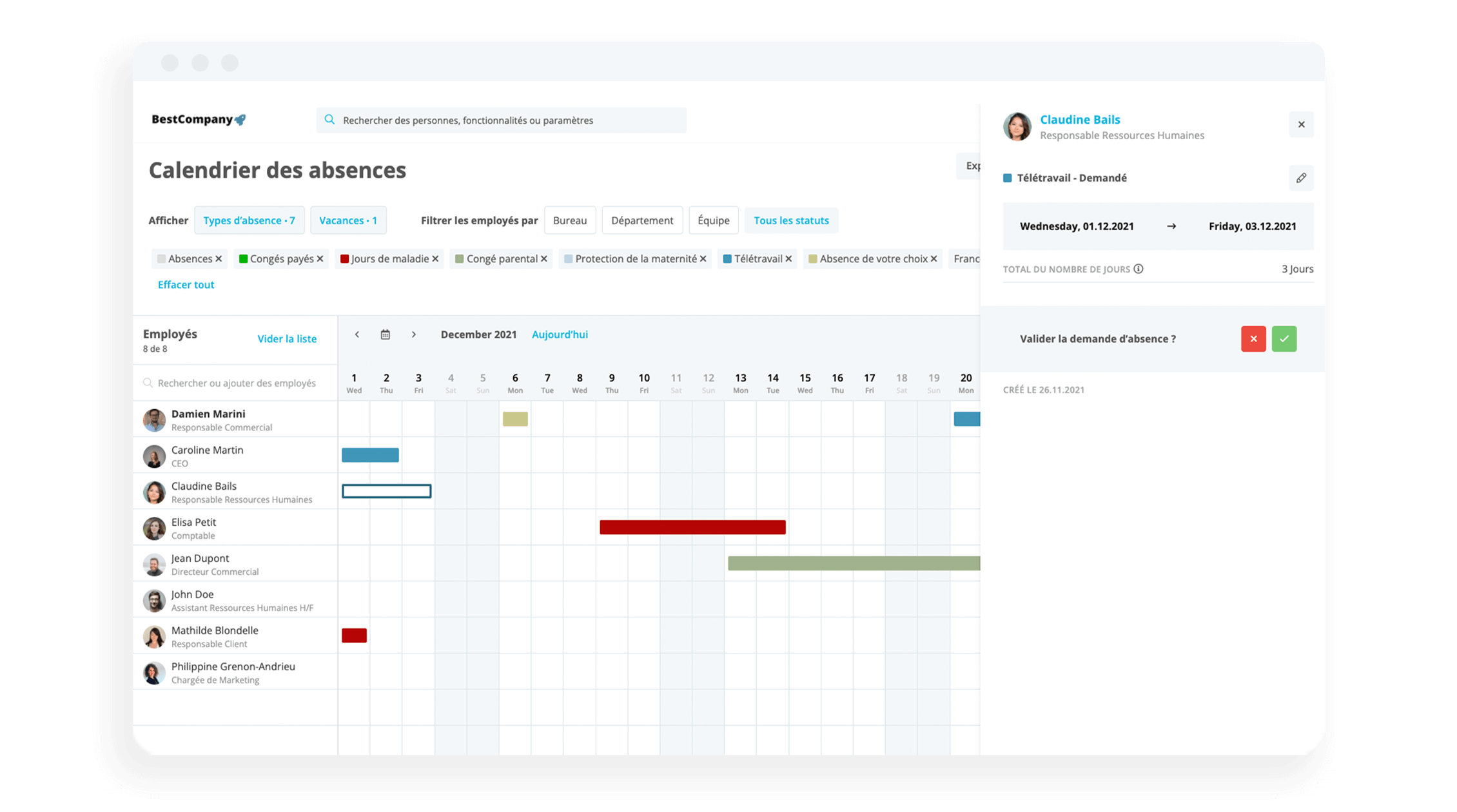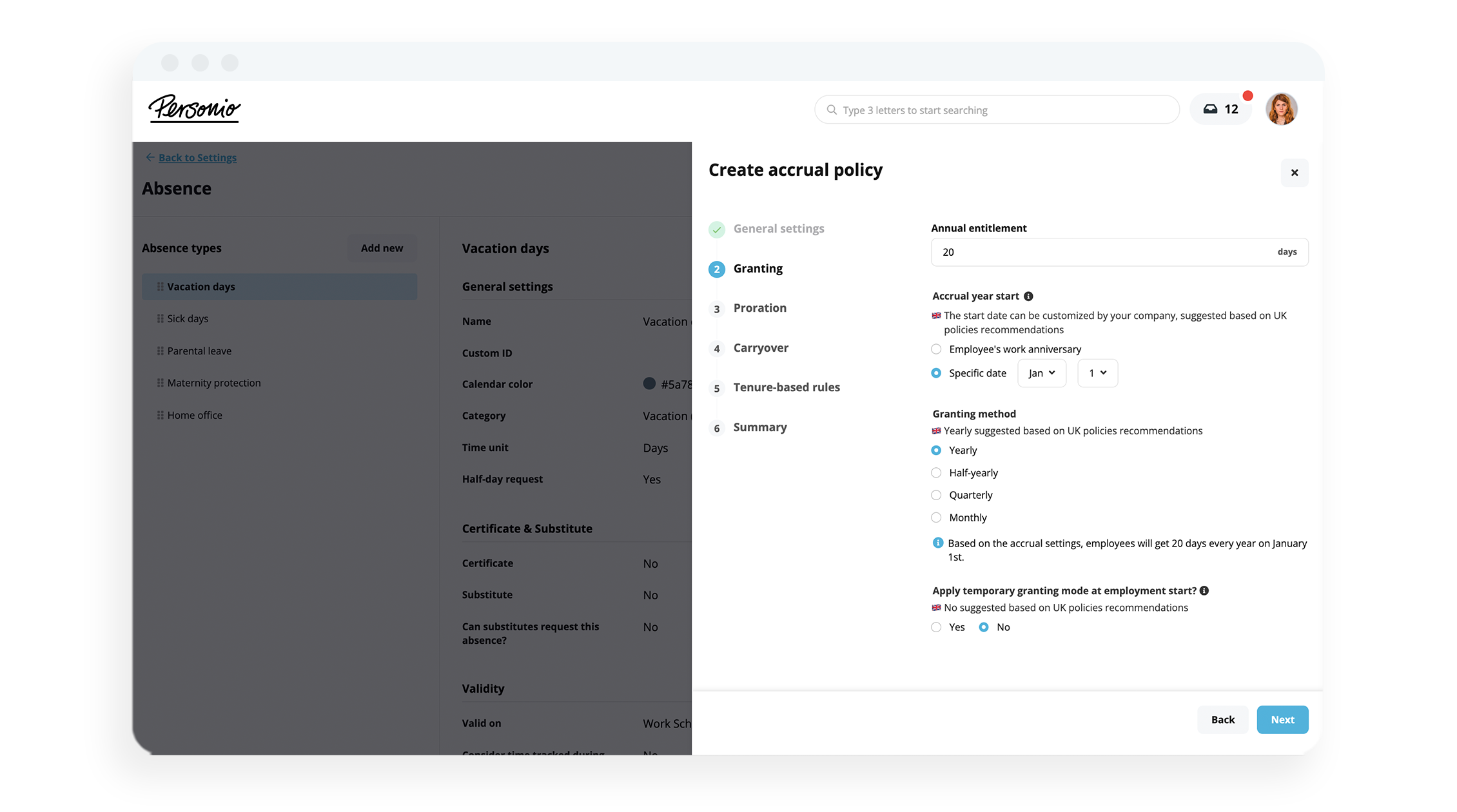The Definitive Guide to Annual Leave

A decent work-life balance is the key to a happy and healthy workforce. And as an employer, you have certain obligations in terms of the annual leave you’re required to grant your employees, whether they’re full-time, part-time or casual workers.
In this post, we’ll discuss what annual leave is, how it works and how much leave you need to grant your employees. Let’s jump in.
Manage annual leave automatically from Personio’s all-in-one HRIS.Contents
- 1What is annual leave in the UK?
- 2What is the average holiday entitlement in the UK?
- 3How do you create a leave policy?
- 4Template: Leave Policy Document
- 5Annual leave examples in organisations
- 6How does holiday accrual work?
- 7How is annual leave calculated?
- 8Managing annual leave requests
- 9Carrying over unused leave
What is annual leave in the UK?
Type of leave | Full-time employees | Part-timeeEmployees (2 days/week) |
|---|---|---|
Statutory annual leave | 28 days (5.6 weeks) | 11.2 days (5.6 weeks) |
Additional leave | At employer's discretion | At employer's discretion |
Bank holidays included | Yes/No (depends on employer) | Yes/No (depends on employer) |
Annual leave is a period of paid time off (PTO) granted to employees by their employer. Employees can use their annual leave for whatever they like, including holidays or just relaxing at home. Leave is typically set out by an employment contract.
What is statutory annual leave?
Statutory annual leave is the minimum amount of leave that UK employers must grant their employees each year. Almost all workers in the UK are entitled to 5.6 weeks of annual leave. For full-time employees, this amounts to 28 days of paid holiday.
Additional annual leave
Employers can choose to offer their employees various types of leave in addition to the statutory minimum of 5.6 weeks. While this is completely at your discretion as an employer, it can be a great way to show your employees that they’re valued.
Does annual leave include bank holidays?
In the UK, there are eight public holidays each year, and employers can choose whether to include these as part of the 28 days of statutory annual leave each full-time employee is entitled to. If bank holidays are counted as part of an employee’s statutory leave, they are left with 20 days (or four full weeks) of leave to take on top of the bank holidays.
You can also choose to allow your employees to work on bank holidays in exchange for taking leave at another time of year. This can be an important element of your diversity, equity and inclusion initiatives, as it allows employees to take time off to celebrate the holidays that are important to them.
Some companies offer bank holidays off in addition to annual leave, which can be a great perk for employees.
What is the average holiday entitlement in the UK?
Manage holidays efficiently and clearly with Personio
According to research carried out by the Trades Union Congress (TUC), the average UK holiday allowance is 33.5 days, including public holidays — more than a full week more than the statutory minimum.
How long is annual leave on average?
A 2017 study found that 40% of the British workforce didn’t take their full holiday allowance — with one in six employees saying they had more than a full working week of leave left unused.
As an employer, it’s important to encourage your employees to use the leave that’s available to them, since this can help to reduce stress and avoid burnout. If you’re concerned about absenteeism, you can always rely on the Bradford factor.
How do you create a leave policy?
A leave policy is a document that outlines the rules and procedures for taking leave within a company. It ensures consistency and fairness in managing employee absences.
The purposes of a leave policy:
To provide clear guidelines on leave entitlements and procedures.
To ensure compliance with legal requirements.
To support workforce planning and business continuity.
Key Elements to Include:
Types of leave: Annual leave, sick leave, parental leave, etc.
Entitlement: Amount of leave employees are entitled to.
Accrual and carry over: How leave is accrued and rules for carrying over unused leave.
Request process: How to request leave and required notice periods.
Approval process: Criteria for approving or denying leave requests.
Leave during notice: Rules for taking leave when an employee resigns.
Special circumstances: Handling leave during busy periods or emergencies.
Where to Store Leave Policies:
Employee handbook: Include the leave policy in the employee handbook.
HR software: Store and manage leave policies in your HR software for easy access and updates.
Company intranet: Make the leave policy accessible on the company intranet.
Template: Leave Policy Document

[Company Name]'s Leave Policy
1. Introduction This policy outlines the leave entitlements and procedures for employees of [Company Name].
2. Types of leave
Annual Leave
Sick Leave
Parental Leave
Compassionate Leave
Unpaid Leave
3. Entitlement
Full-time employees: 28 days of annual leave per year.
Part-time employees: Pro-rata based on hours worked.
4. Accrual and carry over
Leave is accrued monthly.
Up to 5 days of unused leave can be carried over to the next year.
5. Request process
Submit leave requests via [HR Software/Intranet].
Provide at least [number] weeks' notice for planned leave.
6. Approval process
Leave requests are subject to approval by [Manager/Supervisor].
Approval depends on business needs and staffing levels.
7. Leave during notice period
Employees can take accrued leave during their notice period, subject to approval.
8. Special circumstances
During peak periods, leave may be restricted.
Emergency leave requests will be considered on a case-by-case basis.
9. Contact Information For any questions regarding this policy, please contact [HR Department/Manager].
Annual leave examples in organisations
The following are examples that organisations may face when it comes to the topic of annual leave and employees taking their holiday...
Example: Employee requests leave during a busy period
Scenario: An employee requests a week of annual leave during the company's peak season.
How to Handle:
Communicate Clearly: Explain to the employee why their leave request during this period is challenging for the business.
Offer Alternatives: Suggest alternative dates when the leave can be taken without impacting business operations.
Compromise: If the leave is essential, consider a partial leave or shorter duration during the busy period, with the remainder taken at a less critical time.
Plan Ahead: Encourage employees to submit leave requests well in advance, especially for peak periods, to allow for better planning and coverage.
Example: "We understand your need for time off. However, this period is crucial for our business. Could we look at alternative dates or perhaps a shorter leave now and the rest later?"
Example: Employee wants to carry over more leave than allowed
Scenario: An employee has 10 days of unused leave but the company policy allows carrying over only 5 days.
How to Handle:
Review Policy Flexibility: Assess if the policy can be temporarily adjusted for exceptional cases.
Offer Solutions: Propose taking some leave now and carrying over the maximum allowed.
Discuss Needs: Understand why the employee wants to carry over more leave and see if there are other ways to support them.
Document Agreement: Ensure any exceptions are documented and communicated clearly to avoid setting a precedent.
Example: "Our policy allows carrying over 5 days, but we understand your situation. Can we agree on you taking 5 days now and carrying over the remaining 5?"
How does holiday accrual work?
Some employers choose to use an accrual system, meaning that employees ‘accrue’ (build up) annual leave from their first day of work. New employees often aren’t permitted to take annual leave in the first year until they have ‘accrued’ it.
How much holiday do employees accrue each month?
You can calculate how much leave employees accrue each month by dividing their total annual leave by 12. For example, a full-time employee who gets the statutory minimum leave is entitled to 28 days of annual leave. This is accrued at a rate of 2.33 days each month (28÷12).
This means that a new employee would be entitled to seven days of leave (or a quarter of the annual allowance) after three months of work.
Accruing and taking leave while on sick or parental leave
Employees still accrue annual leave if they’re on sick leave or maternity, adoption or paternity leave. An employee can also take leave while they’re on long-term sick leave. This usually means that they will receive 100% of their normal salary for the period of their leave, rather than the amount they are entitled to under statutory sick pay.
How is annual leave calculated?
Employees are entitled to at least 5.6 weeks of annual leave per year. This means that to calculate the number of days of leave they’re entitled to, you need to multiply the number of days they normally work in a week by 5.6. For a full-time employee, this adds up to 28 days.
How do you calculate pro-rata annual leave?
Part-time employees are also entitled to 5.6 weeks of annual leave, calculated on a pro-rata basis. For example, an employee who works two days a week is entitled to 11.2 days of paid leave each year (5.6×2).
Partial days of annual leave
When an employee has a fraction of a day of annual leave to take, their employer is not allowed to round this down to the nearest whole number. However, they are also not required to round it up to the next whole number either.
Instead, employers should speak with their employees about how they can use partial holiday days. For example, an employee with 3.5 days of annual leave to take may agree to take a half-day off as part of their leave.
Managing annual leave requests
There are certain rules that both employees and employers must follow when it comes to requesting, approving and denying annual leave.
When can an employee request leave?
When they want to request annual leave, an employee must give notice of at least twice the period of leave they want to take, plus one day. This means that if they want to take a week of leave, they should put in their request at least two weeks plus one day before the date their leave would start.
Can an employer dictate when leave is taken?
Employers have the right to:
Tell employees to take annual leave on specific days, such as bank holidays or days when the business is closed. In this case, they must give the employer notice of at least twice as long as the leave they want to impose.
Impose restrictions on when leave can be taken, for example by not allowing anyone to take time off during busy periods. Any restrictions should be laid out clearly in your employee handbook.
Can an employer cancel a holiday once it’s been approved?
An employer can refuse a leave request or cancel leave that has already been approved, as long as they give notice of at least the period of the leave plus one day.
Carrying over unused leave
Employees can sometimes ‘carry over’ part of their unused annual leave into the next year. Whether or not this is possible should be detailed in their employment contract.
If a worker is entitled to the statutory minimum of 28 days of leave, the maximum they can legally carry over into the next year is eight days. If they get more than 28 days’ leave, you can choose to allow them to carry over any additional leave as well.
Holiday pay when an employee leaves their job
The only time when an employer can pay an employee instead of them taking their annual leave is when an employee leaves their job. Employers must pay departing employees for any unused leave. On the flip side, if an employee leaves having used more than their leave allowance, you can deduct this from their final pay.
Do you have a leave management system?

The world of work is only becoming more complex. The last thing you should be worrying about is calculating holiday entitlements, tracking them or ensuring you are legally compliant. Allow us to help.
Personio is an all-in-one HR software that helps upgrade your people operations for now and the future. That includes a leave management software that can manage holiday requests, track every kind of leave (from emergencies to sicknesses and bank holidays) alongside all of your other core HR processes.
Over 12,000 customers in the UK and Europe trust us to help. Get in touch with one of our helpful HR experts today, or start your own free trial to give Personio a go right away.
